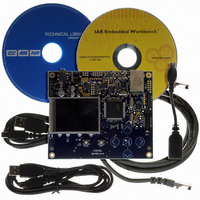ATEVK1105 Atmel, ATEVK1105 Datasheet - Page 675

ATEVK1105
Manufacturer Part Number
ATEVK1105
Description
KIT EVAL FOR AT32UC3A0
Manufacturer
Atmel
Series
AVR®32r
Type
MCUr
Datasheets
1.ATAVRONE-PROBECBL.pdf
(16 pages)
2.ATEVK1104.pdf
(826 pages)
3.ATEVK1105.pdf
(28 pages)
Specifications of ATEVK1105
Contents
Evaluation Board, Software and Documentation
Processor To Be Evaluated
AT32UC3A0512
Processor Series
AVR
Data Bus Width
32 bit
Interface Type
USART, TWI, USB, SPI, Ethernet
Operating Supply Voltage
3.3 V
Silicon Manufacturer
Atmel
Core Architecture
AVR
Core Sub-architecture
AVR UC3
Silicon Core Number
AT32UC3A0512
Silicon Family Name
AVR
Kit Contents
Board CD Docs
Rohs Compliant
Yes
For Use With/related Products
AT32UC3A0
Lead Free Status / RoHS Status
Lead free / RoHS Compliant
- Current page: 675 of 826
- Download datasheet (20Mb)
32.5
32.5.1
32.5.2
32.5.3
32.5.4
32058J–AVR32–04/11
Product Dependencies
I/O Lines
Debug operation
Power Management
Interrupt Sources
The pins used for interfacing the PWM may be multiplexed with PIO lines. The programmer must
first program the PIO controller to assign the desired PWM pins to their peripheral function. If I/O
lines of the PWM are not used by the application, they can be used for other purposes by the
PIO controller.
Not all PWM outputs may be enabled. If an application requires only four channels, then only
four PIO lines will be assigned to PWM outputs.
The PWM clock is running during debug operation.
The PWM clock is generated by the Power Manager. Before using the PWM, the programmer
must ensure that the PWM clock is enabled in the Power Manager. However, if the application
does not require PWM operations, the PWM clock can be stopped when not needed and be
restarted later. In this case, the PWM will resume its operations where it left off.
In the PWM description, Master Clock (MCK) is the clock of the peripheral bus to which the
PWM is connected.
The PWM interrupt line is connected to the interrupt controller. Using the PWM interrupt requires
the interrupt controller to be programmed first.
AT32UC3A
675
Related parts for ATEVK1105
Image
Part Number
Description
Manufacturer
Datasheet
Request
R

Part Number:
Description:
DEV KIT FOR AVR/AVR32
Manufacturer:
Atmel
Datasheet:

Part Number:
Description:
INTERVAL AND WIPE/WASH WIPER CONTROL IC WITH DELAY
Manufacturer:
ATMEL Corporation
Datasheet:

Part Number:
Description:
Low-Voltage Voice-Switched IC for Hands-Free Operation
Manufacturer:
ATMEL Corporation
Datasheet:

Part Number:
Description:
MONOLITHIC INTEGRATED FEATUREPHONE CIRCUIT
Manufacturer:
ATMEL Corporation
Datasheet:

Part Number:
Description:
AM-FM Receiver IC U4255BM-M
Manufacturer:
ATMEL Corporation
Datasheet:

Part Number:
Description:
Monolithic Integrated Feature Phone Circuit
Manufacturer:
ATMEL Corporation
Datasheet:

Part Number:
Description:
Multistandard Video-IF and Quasi Parallel Sound Processing
Manufacturer:
ATMEL Corporation
Datasheet:

Part Number:
Description:
High-performance EE PLD
Manufacturer:
ATMEL Corporation
Datasheet:

Part Number:
Description:
8-bit Flash Microcontroller
Manufacturer:
ATMEL Corporation
Datasheet:

Part Number:
Description:
2-Wire Serial EEPROM
Manufacturer:
ATMEL Corporation
Datasheet:










